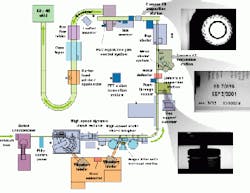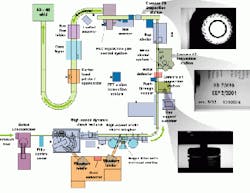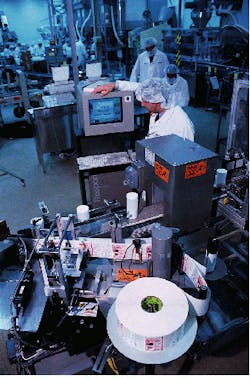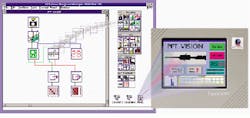MACHINE VISION ADDS quality control TO PHARMACEUTICAL PRODUCTS
MACHINE VISION ADDS quality control TO PHARMACEUTICAL PRODUCTS
John Haystead, Contributing Editor
In pharmaceutical production, inadequate quality control is not only bad business practice, it`s intolerable. Although in any industry, missing labels, incorrectly filled bottles, or badly sealed containers will result in reduced consumer confidence, in the pharmaceutical industry, such poor quality standards would result in immediate product recall, FDA sanctions, and perhaps even product liability litigation.
Pharmaceutical companies, therefore, must work to reduce the possibility of such events occurring and ensure they can never happen. To meet these requirements, pharmaceutical vendors are turning toward vision-inspection systems that can verify, check, and discard products that are incorrectly packaged, sealed, or labeled.
In manufacturing bottled barium sulfate powder suspensions, E-Z-EM (Westbury, NY) required a system that could perform all of these functions. E-Z-EM`s barium-powder suspensions coat the lining of the gastrointestinal tract to enhance the contrast of many medical x-ray imaging procedures. Producing a correctly bottled, sealed, and labeled product is of the utmost importance.
Multifunction machine vision
To perform such quality-control tasks, the company integrated a multifunction machine-vision inspection system into its production line. In operation, the multistation, Passport 440 inspection system from PPT Vision (Eden Prairie, MN) simultaneously performs in-line inspection tasks including date-code printing verification, label-positioning, cap-tightness, and safety-seal-positioning (see Fig. 1). Housed in a 100-MHz Pentium PC with 1.6-Gbyte hard drive and 16-Mbyte RAM, the Passport 440 system incorporates custom-designed image-capture, image-processing, and I/O boards and can simultaneously manage four CCD-camera inspection stations.
E-Z-EM currently implements three such stations on its production line. The Passport host processor and monitor are centrally located so that production personnel can access and view the system on the factory floor. Equipped with audible alerts and warnings, the system does not require constant monitoring or operator control. A 14-in. industrial touch-screen display is used for initial operator setup and control-panel configuration.
Filling bottles
At the start of the bottling line, dispensers automatically fill polyethylene bottles with premixed barium powder. Each bottle is then weighed to determine if it is filled correctly and then passed to a machine that applies and tightens a plastic-lined cap at a prespecified torque.
After the cap is placed, the bottle passes through the first of three Passport inspection stations (see figure). At the first station, an IR sensor triggers an LED strobe light, and a CCD-camera inspects the top of the bottle. Both the presence and correct placement of the cap are checked, and defective products are shunted into a reject bin.
According to Dennis Santucci, PPT Vision senior account manager, proper lighting and positioning are critical for such inspection. "Because white light creates chromatic aberration when refracted through camera lenses, monochromatic LED lighting was used to provide sharper- contrast images." LEDs also provide a more uniform light output from flash to flash and generate less heat than conventional strobe lights.
After capping, each bottle passes through a metal detector from Loma Systems (Elk Grove Village, IL). Labels with preprinted date/lot codes are then applied to each bottle. As a printed label is attached to one bottle, the printing of the next bottle`s label begins. Printed labels are optically examined by a second Passport 440 station before being applied to the next bottle.
"By examining the date/lot code as the label is printed, rather than after it is placed on the bottle, improperly printed labels can be discarded before they are placed on the containers," says Michael Raspler, E-Z-EM industrial engineer. Damaged labels, missing letters or numbers, extra or missing ink, and incorrect information are detected by the Passport 440. If any of these errors are detected, the labeling process stops before additional labels are printed.
Boxed and labeled
After labels are attached to the bottles, an LD-10-02 miniature luminescent UV sensor from Datalogic (Scotts Valley, CA) verifies that a label has been applied by illuminating a special UV coating on the labels. After verification, a label is placed on the top lid of each bottle. Then, a tamper-evident seal is shrink -wrapped around the lid of each bottle.
Tamper-evident seals are pre printed with a repeated pattern of the company`s logo. In addition to verifying the presence of the top label and seal, a gray-scale recognition algorithm on a third Passport system compares the top label and seal`s position against a preset range of template parameters to determine if it is in the correct position.
After bulk-collating and boxing, another product-identification and date/lot code label is applied. A barcode scanner from Accusort (Telford, PA) verifies that the correct product label has been placed on the box. Currently, an operator visually verifies the correctness of the human readable date/lot code on this label, but Raspler says he is considering adding a fourth Passport station to handle this date/lot code inspection.
Raspler says the most challenging part of the implementation was validating that the system would meet all of E-Z-EM`s inspection requirements. "Our overriding consideration was user-friendliness and ease of programming." Although Raspler recognized that there was a considerable amount of proprietary hardware and software in the PPT Vision system, this was outweighed by the ease of systems integration with programmable logic controllers. "The icon-based programming environment helped us to evaluate the capabilities of the system, and, once installed, system parameters could be easily adjusted after the required preprogrammed security measures were met."
On the E-Z-EM bottling line, three inspection stations are used to perform separate image-processing tasks. At the first station, the system verifies whether the bottle lid has been properly placed. At the second station, the system reads and checks the dot/late code printed on the bottle`s label. Finally, the system checks whether the tamper-evident seal has been placed and properly aligned.
Image processing puts production lines to work
At each of the three Passport 440 inspection stations installed at E-Z-EM, images are acquired by the PPT Vision DS2 640x480, double-frame-rate, asynchronous, frame-store CCD cameras that allow the system to simultaneously handle images from up to four inspection stations. Each camera is linked via a coaxial cable to a PC-based camera interface board that is in turn connected via a shielded cable to the frame grabber. Because up to four video signals can be digitized by the same board, the video signals are first multiplexed to allow concurrent processing of the multiple split-screen images that are displayed on a single monitor.
A proprietary 17-Mbyte/s bus links the frame grabber with a C30-based image-processing board. Although most data-intensive processing is handled on the image-processor board, only raw image data in regions of interest are transferred across the bus.
Two field-programmable gate arrays (FPGAs) on-board the image processor manage the pipeline data path and memory-addressing interfaces. "The FPGA data path is integrated with the DSP processor, interrupting the DSP with events as pipeline processing occurs. This configuration distributes hardware and software tasks for optimum throughput and allows the board to be easily reconfigured," says Steven Tonkin, PPT vision engineering manager.
Camera and strobe-light trigger signals are hard-wired through an I/O board that has 24 user-programmable, optically isolated parallel I/O ports. Opto-22 (Temecula, CA) process-control contact closures provide an I/O interface to accept/reject mechanisms located on the production line. Optically isolating devices prevent ground-loop interference or spiking between the vision system`s I/O and PLD control devices that could cause false triggering.
Icon-based programming speeds software development
To speed image-processing development, many manufacturers of vision systems, image-processing boards, and third-party software are offering graphical programming environments. In the development of the E-Z-EM machine-vision system, individual cameras and inspection tasks were programmed using the PPT Vision (Eden Prairie, MN) icon-based Vision Program Manager (VPM). To use the software, developers select on-screen icons from a system toolbox and connect them to perform execution tasks and set inspection values.
Composed of a combination of C++, assembly language, and Windows-based software, the VPM toolkit downloads developed code to the C30 image-processing board. "Although the PC is used during program development, in operation the DSP and frame grabber handle inspection operations autonomously, allowing the PC to run motion-control and data-collection tasks," says Arye Malek, PPT Vision vice president of marketing. With the addition of an Ethernet card, the PC can also function as a LAN manager.
After statistics are collected from the image-processing system, they can be downloaded into other Windows-compatible spreadsheet programs such as Excel or PPT`s Quickchart display program for charting inspection data. QuickChart can monitor various inspection parameters and display multiple charts simultaneously. Chart types include on-line monitoring of product quality trends, histograms to check the distribution of single variables, and X-bar/R Charts for analysis of maximum, minimum, and mean values.
Using the Vision Program Manager drag-and-drop graphical interface, inspection tasks can be programmed into the Passport system without the use of programming languages. Tasks are defined using visual flow charts and connected with colored lines that indicate execution and data flow. Once the inspection task has been set up, custom operator interfaces can be created.



